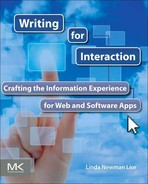Review Check List
Basic Rules
1. Understand your users. What level of knowledge is expected? Try to sit in the customer chair’s, and see if everything makes sense and is friendly.
2. Provide enough information for users to make an informed choice. Language should be appropriate and consistent throughout. But don’t overload the UI with text.
3. Pages should be well organized. Spacing and alignment should indicate the workflow. Controls and options should be grouped logically so that it’s clear what items belong together.
4. Controls should be intuitive and provide meaning. For example, don’t let the user select an item from an empty list; don’t use acronyms that the user might not understand.
5. Text should be clearly written. There should be no spelling mistakes, typos, or grammatical errors.
General UI Review
1. Default values are provided and appropriate.
2. The default option is the recommended option and is listed first (where applicable).
3. Unit is appropriate for the input (e.g., 60,000 seconds is expressed in minutes, and it should be clear to the user). Units should appear in parentheses as part of the text. Example: “Timeout limit (minutes):”
4. Input fields are sized according to expected user input. This provides a visual cue as to the expected values that may be entered. For example, if the string the user will enter is a number between 0 and 999, restrict the user from entering strings exceeding three characters or containing nonnumeric characters.
5. If control text is not self-explanatory, then an explanation, or help link to an explanation, is provided.
6. Examples are provided, and appropriate as needed. For example, if the user must enter a URL, an example using the correct URL format displays under the text box.
7. Right-click menus are included, in the correct order; match the corresponding task if provided elsewhere, such as in a tasks pane.
8. Menus and buttons opening a dialog should end with “…”. If the action is triggered immediately when clicking the button, no … is used. Examples [Add …], [Delete]
9. Button names, menu items, and dialog title bars are written in title case, or sentence case (just be consistent).
10. Controls are written in sentence case without ending punctuation.
Dialogs and Wizards
11. UI focus is on the correct control.
12. UI validation blocks users from misconfiguring the feature.
13. Page titles match page functionality. If launched from a button, the title reflects the button label.
14. Controls are the standard sizes.
15. Text is aligned properly (usually aligned left).
16. Radio buttons and checkbox controls are aligned appropriately with the control text (top, left). This is particularly important when the text wraps.
17. Button labels are appropriate (e.g., “Add” versus “New,” “Delete” versus “Remove.”)
18. Pages and controls are spaced appropriately so that the user can easily see the relationship between the controls (no large gaps, not too close together). If the page is being localized, remember to leave 30 percent extra line space for localization.
19. Subordinate controls are indented under the superior control, and are grayed out until relevant.
20. Defaults change according to previous selections, and invalid selections are grayed out.
21. Property sheets and wizard pages are sized correctly and consistently throughout the product.
22. If additional steps are required after leaving the wizard or dialog, the user is notified of such steps.
Validation
23. Validate! Make sure that you validate all user input fields.
24. Users cannot move to the next wizard page if parameters are wrong or missing.
25. All errors are handled, and a message is provided.
26. Validation messages are appropriate and helpful. For example, “Invalid port range” is not a good message. A better message is: “The specified port range is invalid. A valid port range cannot exceed 65535.”
Popup Messages
Accessibility (Hotkeys, Tabs)
33. Tab order is correct: top to bottom, left to right.
34. Each control has a distinct access key. In the wizard page, the N and B letters are used by the Next and Back buttons, respectively, and should not be used within the page. The same is true for the A letter in property pages, where it is being used by the Apply button.
35. Access keys are assigned to visible (thick) letters. Do not use I, l, j, p, t, i.
36. No access keys are assigned for OK, Finish, Cancel, or Help command buttons because OK and Finish are assigned the function of ENTER, Cancel is assigned the function of ESC, and Help is assigned the function of F1. Make sure that these keys work for dialog boxes.
